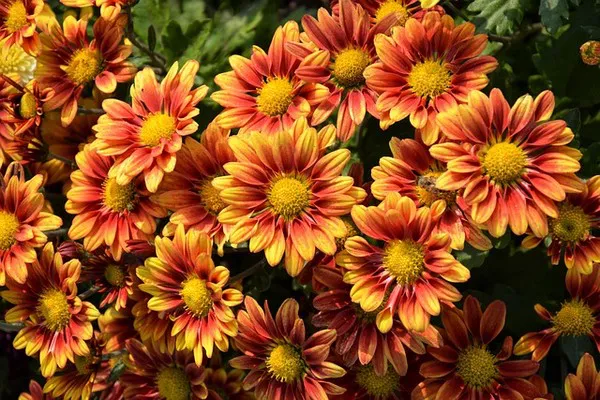Chrysanthemum plants, known for their vibrant and diverse blooms, have long held a special place in gardens, landscapes, and floral arrangements. With their rich history and cultural significance, these perennial wonders are a testament to nature’s artistry. One question that often arises among enthusiasts and gardeners alike is: How long do chrysanthemum plants last? Delving into the intricacies of their lifecycle and the factors that influence their longevity provides a deeper appreciation for these captivating botanical gems.
Chrysanthemums, commonly referred to as mums, boast a remarkable lifespan that varies based on several factors, including their specific variety, growing conditions, care regimen, and intended use. Understanding these elements is crucial for cultivating thriving chrysanthemum plants that continue to flourish year after year.
Lifecycle of Chrysanthemum Plants:
Chrysanthemums are perennial plants, meaning they have the innate ability to return year after year, provided they are properly nurtured and maintained. However, the way they grow and bloom is subject to the environment in which they are cultivated.
1. Growing from Cuttings:
Many gardeners opt to propagate chrysanthemums from cuttings, which involves taking a portion of an existing plant and encouraging it to develop roots and grow into a new plant. This method allows for genetic continuity and helps ensure that the new plant will exhibit similar characteristics to the parent plant.
2. Budding and Blooming:
Chrysanthemums typically follow a cycle of growth, flowering, and dormancy. In most cases, they will produce vibrant blooms during the fall months, making them a popular choice for autumnal displays. The duration of their blooming phase can vary, but it often lasts several weeks, adding a burst of color to gardens and landscapes.
3. Dormancy and Winter Care:
As temperatures drop and winter approaches, chrysanthemum plants naturally enter a period of dormancy. During this phase, their above-ground growth recedes, and they conserve energy for the upcoming growing season. Providing proper winter care, such as mulching and protecting them from harsh conditions, can enhance their chances of surviving the colder months.
Factors Influencing Lifespan:
Several key factors play a pivotal role in determining how long chrysanthemum plants will thrive:
1. Variety:
Chrysanthemum plants come in a diverse array of varieties, each with its own unique characteristics and growing habits. Some varieties are naturally hardier and longer-lived, while others may have a more limited lifespan. Selecting varieties that are well-suited to your region’s climate and growing conditions can contribute to their overall longevity.
2. Growing Conditions:
Providing optimal growing conditions is essential for chrysanthemum plants to flourish. Adequate sunlight, well-draining soil, and proper spacing are crucial factors that impact their overall health and lifespan. Additionally, consistent watering and fertilization help sustain their vitality.
3. Pest and Disease Management:
Vigilance in monitoring for pests and diseases is crucial for maintaining the health and longevity of chrysanthemum plants. Regular inspection, prompt intervention, and adopting integrated pest management practices can prevent issues from escalating and impacting the plant’s lifespan.
4. Pruning and Deadheading:
Regular maintenance, including deadheading (removing spent flowers) and selective pruning, can promote continuous blooming and extend the overall flowering period. Pruning also helps maintain the plant’s shape and prevent overcrowding, contributing to its overall longevity.
5. Winter Protection:
Chrysanthemums require proper care during the dormant winter months. Applying mulch to insulate the roots and providing adequate shelter from freezing temperatures and harsh winds can prevent winter damage and increase their chances of reemerging in the spring.
Extending the Lifespan:
To ensure the longevity of chrysanthemum plants and enjoy their beauty for years to come, consider implementing the following practices:
Selecting Suitable Varieties: Choose chrysanthemum varieties that are well-suited to your climate and growing conditions to enhance their chances of thriving.
Optimal Planting: Plant chrysanthemums in well-draining soil with sufficient sunlight. Adequate spacing between plants allows for proper air circulation and reduces the risk of disease.
Regular Maintenance: Regularly deadhead spent flowers and prune to encourage continuous blooming and maintain the plant’s shape.
Pest and Disease Management: Monitor for pests and diseases, and take proactive measures to address any issues promptly.
Winter Care: Provide adequate winter protection, such as mulching and shelter, to safeguard the plant during the dormant period.
In conclusion
the lifespan of chrysanthemum plants is influenced by a combination of factors, including variety, growing conditions, care, and maintenance. With proper attention and a well-executed care regimen, these perennial beauties can thrive and continue to grace gardens and landscapes with their vibrant blooms for many years. As a testament to the wonders of nature, chrysanthemum plants offer a rewarding and captivating journey for both novice and seasoned gardeners alike.


